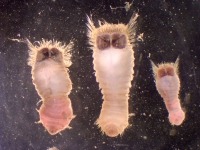
(Photo: Huntsman Marine Science Centre)
Mud Owl
Sternaspis fossor
This worm is very plump, with a body that can be up to 1.5 centimetres long and one centimetre wide. The skin is usually white or grey. The body consists of 31 segments. It has two prominent, fan-shaped, brown plates on the posterior end of its body. These bear long bristles.
Authority
Stimpson, 1853
Classification Details
Phylum: Annelida (worms); Class: Polychaeta (bristle worms)
Habitat
Found in the northwestern Atlantic Ocean, from Canada to the northeastern United States. It was described from the Bay of Fundy. Found in mud and sand seabeds in depths of 20 to 153 metres. This worm burrows head down, leaving the gills on its posterior exposed.
Diet
Subsurface deposit feeder. They can turn their pharynx (top part of their digestive tract) inside out. They then use it to scoop fine particles from the seabed and feed on the organic material in these.
Reproduction
Sexes are separate. Gonads are in sacs behind their sixth segment. Scientists think these worms eject eggs or sperm into the seawater and these are fertilized externally. During the very short larval period (around two days) the larvae do not feed but survive on their egg yolk.
Fun Facts
These worms are known as mud owls. Their large, round, ventral shields look a bit like owl eyes and their body is shaped like a resting owl.
References
Pocklington P (1989) Polychaetes of Eastern Canada – An Illustrated Key to Polychaetes of Eastern Canada Including the Eastern Arctic. Mont Joli: Department of Fisheries and Oceans. Purschke G, Böggemann M and Westheide W (2019) Sternaspidae in Handbook of Zoology Annelida: Volume 1: Annelida Basal Groups and Pleistoannelida, Sedentaria I. Boston/Berlin: Walter de Gruyter GmbH & Co. pp. 440–453. Read G and Fauchald, K (2020) World Polychaeta database. Sternaspis fossor Stimpson, 1854. Accessed through: World Register of Marine Species at: http://www.marinespecies.org/aphia.php?p=taxdetails&id=131241 Accessed online 22 January 2020. Shelley R, Widdicombe S, Woodward M, Stevens T, McNeill CL and Kendall MA (2008) An investigation of the impacts on biodiversity and ecosystem functioning of soft sediments by the non-native polychaete Sternaspis scutata (Polychaeta: Sternaspidae). Journal of Experimental Marine Biology and Ecology 366, 146–150. Sendall K, Salazar-Vallejo SI (2013) Revision of Sternapsis Otto, 1821 (Polychaeta, Sternaspidae). ZooKeys 286, 1–74.

